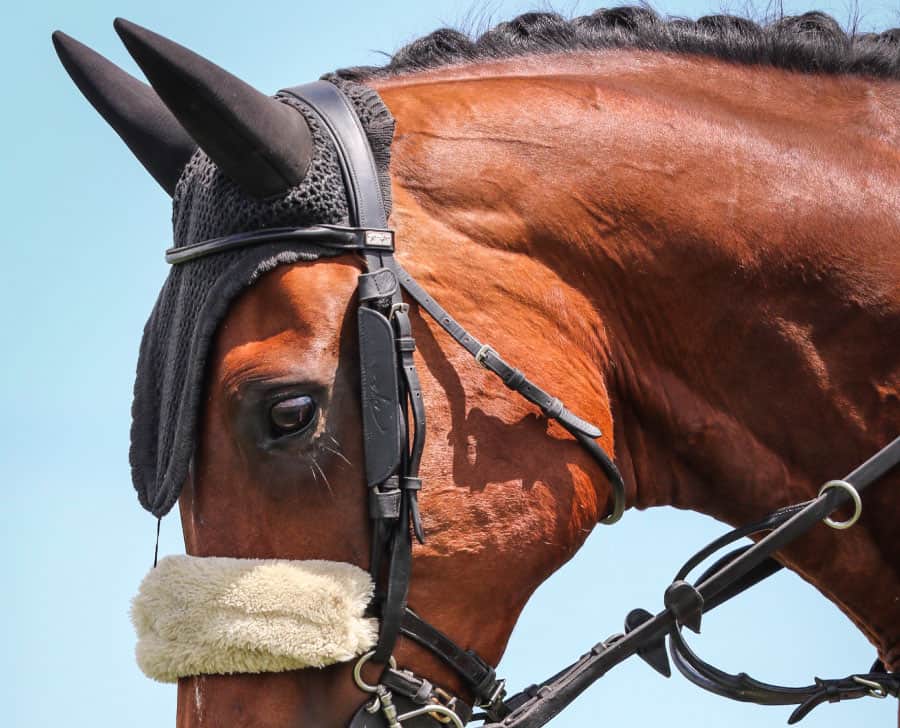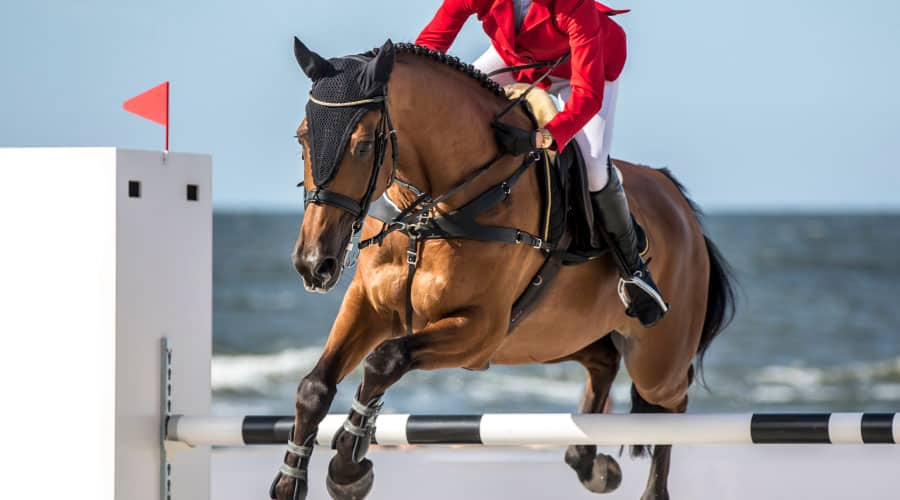
Ear covers (ear bonnets) look like little ‘hats’ that horses wear during showjumping competitions. Ever wondered why show jumpers wear ear covers when riding or competing? What is the purpose of ear covers? Do they even work?
Showjumpers wear ear covers to distort or muffle sound, so a horse can’t react to things like loud crowds or normal show noises that can cause them to get spooked, be distracted, or become anxious during a showjumping round. Ear covers can also be used in everyday training if a horse is “sound-sensitive”, and to keep flies and bugs away from a horse’s ears.
Ear covers are also known as ear bonnets, fly-bonnets or, earmuffs, and are an equestrian accessory that is worn on top of a horse’s head and over the ears.
Reasons why show jumpers wear ear covers
Earplug to reduce sound
Earplugs are placed inside the horse’s ear to muffle sound; the ear bonnet is then placed over the ears to hide the earplugs and ensure they don’t fall out during riding. Ear covers can also be used without earplugs and are made of special sound distorting material, but more about this later.
In competitions
During showjumping competitions, and especially at top level competitions, large crowds of spectators usually gather to watch riders compete. This is the main reason for using earplugs and bonnets in showjumping as this could make horses anxious by the noise they hear all around them. The crowd could also act as a big distraction for the horse while jumping.
Similarly, in indoor arenas, spectators are seated awfully close to the arena, and not to mention that you can hear a pin drop inside an indoor arena, especially when the stakes are high. Ear covers can muffle and help block out spectator noise and prevent a horse from getting anxious or frightened by the surrounding noise. Ear bonnets can aid in keeping a horse focused and not become distracted by the sound easily.
Sound sensitive horses
Ear covers can also be used in everyday training for horses that are “sound-sensitive”. Show jumpers nowadays are sitting on a lot of well-bred horses, and the problem with too much blood is that horses are becoming more sensitive, making them more difficult to train. Ear covers can be used in everyday training for similar reasons you would use them in the ring for, to distort noise and keep horses focused. When a horse’s hearing is diminished, they become more “zoned in” on the rider and the rider’s aids.
Transport
Transporting horses could also be another reason to use earplugs and bonnets to limit the noise inside a horse-box or truck when transporting horses. Show jumpers want to keep their horses as relaxed as possible, so they want the transport of their horses to shows to be as stress-free and calming as possible.
Keep bugs away
Ear bonnets are also used to keep flies and bugs away from a horse’s ears. Horses could often be distracted by bugs flying around their ears and using an ear bonnet will help keep them from bothering the horse while jumping a course. For the same reason, ear covers are sometimes used when turning a horses out into the field or paddock.

Fashion
Ear covers are also widely used for fashion or even on a sponsorship request. Top riders might be sponsored by brands that request them to use ear covers with the sponsor’s branding and colors. Sometimes riders like to match the ear bonnets with the rest of their wardrobe and saddle pads for a more cohesive look. Ear bonnets come in all sorts of different colors, styles and designs and can range in price depending on the brand and design.

Do ear covers work?
Even though we are not sure as to which degree of sound level a horse can hear with the use of ear bonnets and earplugs, that does not mean that ear covers and plugs are not effective. Even with the use of earplugs, the horse’s hearing may still be intact, but the spooking, startling, and being distracted by noises are substantially diminished.
Although ear covers distort the sound, it will not completely block it out. If you are standing in the middle of a cheering crowd, you could cover your ears and the sound will be diminished, but you would still hear it to some extent. Every bit helps and if it can help a horse even just a little bit to be less anxious and more focused, then yes, they work.
What type of ear covers should you use?
Types of ear covers
There are two types of ear covers. Normal, plain ear covers that are usually used when needed to stuff the ears, use plugs or keep flies away from a horse. And the newer tech bonnets that use thick distortion fabric that is heavily padded around a horse’s ear.
Reason for use
If you are using an ear bonnet to keep flies and insects from bothering your horse during work or in the paddock, a normal everyday bonnet could be used. If you need to distort sound or your horse is sound-sensitive, then you can choose a bonnet that is padded, or use earplugs under the normal bonnet to reduce the sound.
Earplugs or stuffing
In the past, and still widely used today; cotton wool was used to stuff a horse’s ears, and then the ear bonnet was placed over the horse’s ears to keep the cotton wool inside the ear. The bonnet was made from fabric that goes over the ears and poll area with a crochet pattern coming down the horse’s face and under the bridle.
Even though using cotton wool as earplugs to stuff the ears are effective, it does not have a protective layer like the commercial earplugs and therefore removal could be difficult (especially if damp). It could also possibly fragment during use or removal, leaving debris behind in the ear.
Similarly, earplugs act in the same way by placing them in a horse’s ears before pulling the ear covers over.
There are different types of earplugs on the market that use different types of foam (sometimes wool) to plug the ears. One study suggests that earplugs made of memory foam have the most significant effect in distorting sounds. Stuffing the ears or using plugs is still the most effective way of blocking out the sound.
Sound distortion
There are some modern types of ear bonnets on the market today that are made specifically to block out sound. The fabric is thicker and layered with “Sound blocking” material around the front of the ear and can come with extra padding to muffle the sound.
Some owners do not like stuffing or plugs, and prefer to use this type of bonnet. They are also less effective in distorting sound than the traditional way of stuffing or using plugs.
Not all horses are accepting of earplugs and some just don’t like something being stuffed down their ears. If the rider cannot make the horse used to the earplugs and accept them then this type of bonnet can be used.

What are the rules of using ear bonnets?
When it comes to competing, most equestrian disciplines permit the use of ear bonnets as well as ear bonnets that have been padded to muffle noise.
Earplugs are still permitted during most showjumping competitions around the world, yet, the use of earplugs is not permitted during eventing, endurance, and dressage competitions. In Dressage earplugs may only be used during prize-giving ceremonies for horses that are sound sensitive or anxious about noise.
Other posts in this series to check out:
Can You Jump in a Dressage Saddle?
Do Show Jumpers Wear Body Protectors?
Why Do Show Jumpers Wear Spurs?
